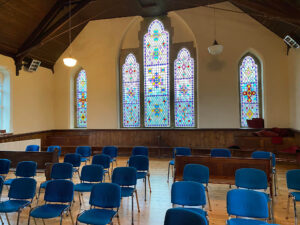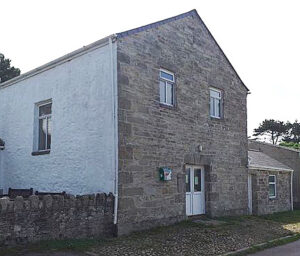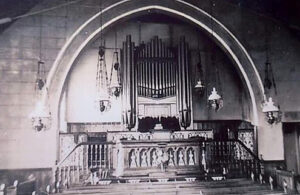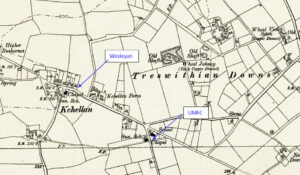Mapping Methodism – Kehelland Wesleyan Meeting House and Chapels
Categories Mapping Methodism2 CommentsThis profile of Kehelland Wesleyan Chapel has been compiled by Jo Lewis and Tony Mansell.
Methodist Meetings / The Meeting House
There was an early Methodist Society in Kehelland.
Kehelland features on a Redruth Circuit week night Preachers’ Plan of about 1818.
1828: The Camborne Circuit book records that there were 62 members of a Society at Kehelland, with 65 in September of the same year, probably meeting in houses.
March 1829: The Steward was a George Bennetts.
The small single storey building attached to the first chapel is still known as “The Meeting House”. This may indicate a structure of some sort on, or near, the site, where this early Society met or in fact be a modernised first Meeting House. The stone is very similar to the stone in the first chapel which may have come from the local quarry. Heritage Gateway notes this small building as an attached vestry (or caretaker’s cottage?).
1831 Wesleyan Chapel
Many of the Camborne Circuit records for the nineteenth century give the date for the building of the first chapel as 1830 which ties in with other accumulated evidence.
Heritage Gateway: Wesleyan chapel, c 1800 with attached vestry (or caretaker’s cottage?), later adapted as a Sunday school after nearby 1891 chapel built (b1). Coursed rubble with granite moorstone dressings;scantle slate roof over annex. Simple 2-storey, 2-wndow front with central doorway. Annex, right of chapel front, has original sash window with some glazing bars removed. Probable end gallery or former gallery.https://www.heritagegateway.org.uk/Gateway/Results_Single.aspx?uid=MCO33096&resourceID=1020
At Lady Day, 25th March, 1831, William Teague paid five shillings rent for a chapel at Kehelland to Mr Praed of Trevethoe in the parish of Lelant, as the land on which the premises stood then belonged to this prominent West Cornwall landowning family. The chapel was certainly then newly built for on the same day in 1831 a lease was granted to William Teague of Camborne, labourer, by William Praed of Trevethoe, Lelant, of a Wesleyan chapel and yard on part of Kehelland, Camborne, occupied by Thomas Jeffery.
The cost of the building of the chapel in 1830 was £220 and the original number of the Trustees was 11.
March 1831: Kehelland had 57 members.
1839: Following the revivals, the number of members increased from 88 to 182, with 35 on trial.
The chapel of 1830 could not contain them all and at the Quarterly Meeting of June 1839 it was passed that a gallery should be added to the building to accommodate more worshippers. There were then 100 members with 200 hearers and a population of 300. The gallery cost £40, the money for which was subscribed. Kehelland at this time was also noted as one of the Camborne Circuit chapels possessing a Sunday school.
Registered as a place of religious worship on 29 October 1850 and again on 21 April 1854.
October 1854: The Kehelland meeting house or chapel and premises then in the occupation of the Society of Methodists was purchased by Lady Basset of Tehidy, along with 36 acres of other nearby land at Kehelland. There is a deed which suggests further land was leased from the Tehidy Estate for a Sunday school and playground 1871.
The Wesleyan chapel can be seen on early maps and its template shows the building adjoined to it.
1891: Became the Sunday school when replaced by the newer chapel next door.
The 1831 chapel sits behind the 1891 chapel, connected to it by a covered walkway which was updated in 2001.
Continues to service as a community hall.
1891 Wesleyan Chapel
 (Barry West)
(Barry West)
 (Barry West)
(Barry West)
Heritage Gateway: Wesleyan chapel, built to replace an earlier chapel that then became a Sunday school (1). Granite rubble with granite dressings; steep slate roof with decorative banding; crested clay ridge tiles and clay finials. Gothic style with features including buttresses, pointed arches and hoodmoulds. Unusual plan with short transept at ritual south side and lean-to porch in the angle. Principal 3-window gable end has large central 3–light traceried window. Interior has original features and fittings including arch-braced roof and pointed arch to organ apse; pitch-pine pews. Rubble road-frontage walls have edge-set copings. An unaltered example in a small village.https://www.heritagegateway.org.uk/Gateway/Results_Single.aspx?uid=MCO33097&resourceID=1020
1890: Contract awarded for building chapel. (Cornishman – Thursday 28 August 1890)
1890: Laying memorial stones. (Cornish Post and Mining News – Friday 28 November 1890)
Built in 1891 as a Wesleyan Chapel.
The new building was opened with some ceremony on Thursday 2nd July 1891. The financial statement showed that the contract was let for £604, the Trustees providing the lime and building stone and that the estimated cost for completing the whole work with the boundary walls, furniture, lamps etc would be about £750. Mr John Odgers of Redruth carried out the whole of the masonry and joinery work, the coloured windows were supplied by Solomon and Co of Truro. The plans and designs for the whole of the work were prepared by Mr Sampson Hill of Redruth, who also superintended the build.
The granting of a new lease in 1895 both regularised and confirmed the construction.
1898: New organ. (Cornish Post and Mining News – Thursday 26 May 1898)
29th August 1911: The chapel Trustees purchased the reversion of the freehold of the property from the Tehidy Estate for £10.
1932: The Wesleyan, Primitive Methodist and the United Methodist Church amalgamated to become the Methodist Church of Great Britain.
1932: Became Kehelland Lower Methodist Church.
1938: Extensive refurb. (Cornish Post and Mining News – Saturday 16 July 1938)
1956: Following the closure of Kehelland Higher Methodist Church (The United Methodist), it was known as Kehelland Methodist Church.
 (Barry West)
(Barry West)
 (Barry West)
(Barry West)
1985: Dedication of pipe organ. (West Briton and Cornwall Advertiser – Thursday 21 March 1985)
The present organ is not the original but was purchased on the closure of the Methodist Church at Pengegon, near Camborne and re-built by Lance Foy of Truro.
2001: Extended, renovated and re-wired with opening of the link building to the Sunday school.
 (Barry West)
(Barry West)
Further reading:
There is extensive documentation at Kresen Kernow and in Facebook.
https://kresenkernow.org/SOAP/search/RelatedNameCode.keyword/CRO%7CUK%7C1235/
https://methodist121.org.uk/chapels/kehelland/
David Thomas on Facebook
At the road junction near the school we descend the gentle hill almost down to the bottom of the village and on the left-hand corner at the road junction encounter the suite of buildings which comprise the present Kehelland Methodist Church. The buildings themselves tell a story which goes back over a period of 190 years or more.
There was certainly a Wesleyan Society at Kehelland as far back as 1818 for in that year a Redruth Circuit week night preachers’ plan refers to the village as a preaching place. Also on 25 April 1822 William Carvosso refers to a crowded meeting inside and outside the ‘house’ at Kehelland so this would suggest some form of early preaching house in the village. At Midsummer 1828 the Society numbered 62 members while in March 1829 the Society Steward is recorded as a George Bennetts. These early Kehelland Methodists may have focused on a building known as a Meeting House which preceded the building of the first Wesleyan chapel in 1830 and indeed part of the present buildings is still known as the ‘Meeting House’. In that year the building was erected at a cost of £220 and on 25 March 1831 a 99-year lease of the newly built chapel premises and land was granted by William Teague, labourer (the lessee of the site from the Praed estate at Lelant) to a George Bennetts, Thomas Jeffrey, Thomas Roberts, William Hewet, John Harvey, Philip Martin, John Sowden and John Bennetts, all yeomen and Jeremiah Jeffrey, blacksmith and William Boase, miner, all of the parish of Camborne. This first Trustee body was therefore heavily dominated by the local farming community. The chapel was registered for worship on 29 October 1850 and again on 21 April 1854. The chapel Trust was renewed on 11 October 1856 and again on 25 August 1874. Further renewals took place on 5 November 1895 (with 16 Trustees) and 1 June 1922.
Chapel membership in the early years was reflective of local religious awakenings. A revival in 1831 increased the members from 57 to 101 and a further revival in 1839 increased the membership from 88 to 182. This second revival led to the construction of a gallery at the rear of the chapel building at a cost of £40 and at this time there were 100 members and 200 hearers recorded. (The same revival led to the building of the Centenary Wesleyan chapel in Camborne).
The first Kehelland chapel did faithful duty for 60 years but in 1890-1891 a brand-new chapel building in the Gothic style was constructed on the plot, just east of the 1830 building, and was opened for worship on Thursday 2 July 1891. The estimated cost was £750 but the actual final bill amounted to £815. The contractor was John Odgers of Redruth, with the building being designed by architect Sampson Hill, also of Redruth.
On 13 June 1895 a new 99-year lease of the chapel premises was granted by the Basset estate. Lady Basset of Tehidy had purchased the freehold of the chapel premises for £815 when the Praed estate lands around Kehelland were auctioned off in 1854. The Trustees were able to purchase the reversion of the freehold of the premises from the Tehidy estate, as from Christmas 1911. In 1910 the Society had numbered 43 members, a considerable decrease from some 80 years before in the 1830s. The chapel was licensed for the solemnisation of marriages without the presence of the Registrar in 1963.
Seven years after the opening of the new chapel in 1891 a pipe organ was installed in 1898 by the Bath firm of Griffen and Stroud. This organ is not however the one in use today as the present instrument is the one from the former closed Methodist chapel at Pengegon, transferred when that chapel ceased to be used for worship. The transferred organ was reopened on 30 March 1985.
Following the building of the second chapel in 1890-1891 the former 1830 chapel continued in use as a Sunday School but in more recent years has been renovated and linked to the newer chapel by an annexe to mark the new millennium, as part of the Vision 2000 scheme to bring the premises more into community use. The new works were reopened over the period of 3-4 March 2001. This also led to the removal of the 1839 gallery at the rear of the Sunday School to facilitate that new usage.
 This picture is very recent one of the first chapel of 1830 which was a relatively plain and simple building.
This picture is very recent one of the first chapel of 1830 which was a relatively plain and simple building.
 The original 1898 organ by Griffen and Stroud of Bath dominates the interior and a wonderful array of oil lamps can be seen. This photo is an early twentieth close up view of the pulpit and organ. The fine detail of the lamps is shown off to advantage while a large hymn board has appeared on the front of the pulpit. (Thanks to David Philp for this photo).
The original 1898 organ by Griffen and Stroud of Bath dominates the interior and a wonderful array of oil lamps can be seen. This photo is an early twentieth close up view of the pulpit and organ. The fine detail of the lamps is shown off to advantage while a large hymn board has appeared on the front of the pulpit. (Thanks to David Philp for this photo).
A fuller account of the early history of the chapel from 1818-1922, which I wrote in 1991, with additional notes and commentary by David Oates from 2015-2016, can be found online within the Downalong Kehelland Facebook page.

 Map:
Map:
I am researching the ‘artist’ Rosie Ellen Levi, otherwise Danecourt, (1889–1971) who lived at Orchard Corner, Kehelland, with her husband Philip Levi (Danecourt).
I believe that she made a bust of John Wesley for Kehelland Wesleyan Chapel: see West Briton and Cornwall Advertiser 5.4.1956, p.9.
Is the location of this bust known and, indeed, anything more about Rosie Ellen?
Any information would be greatly appreciated, please.
I’m afraid no Philippa. Everything we know about the chapel has been included. Best, Tony